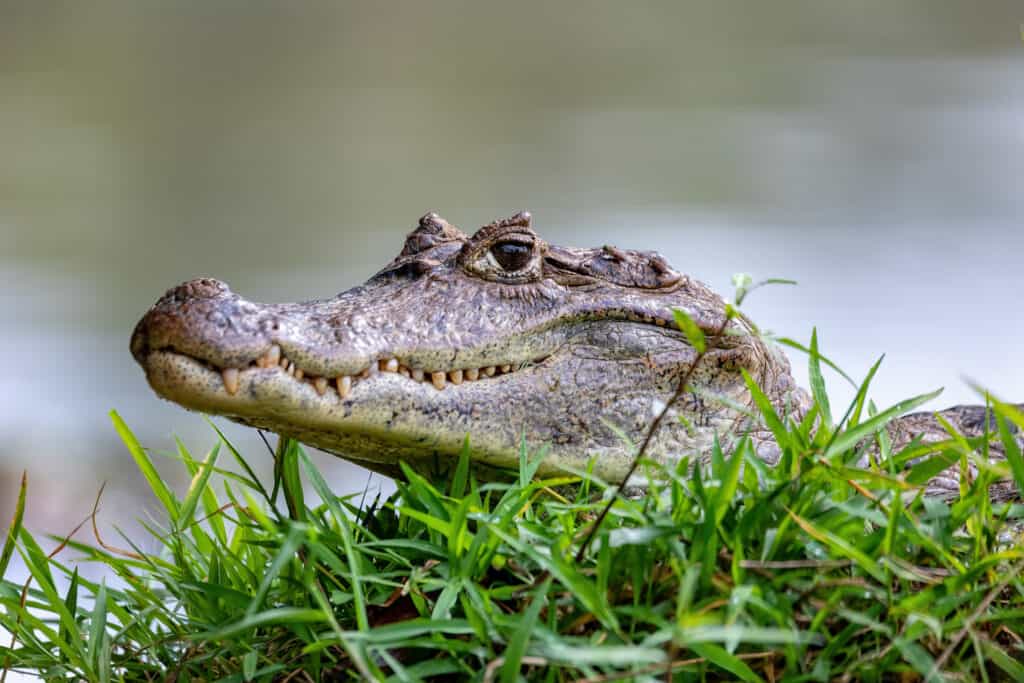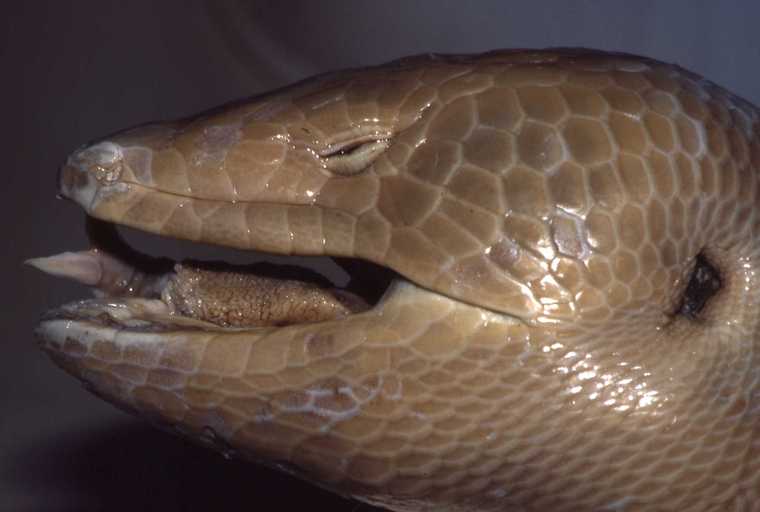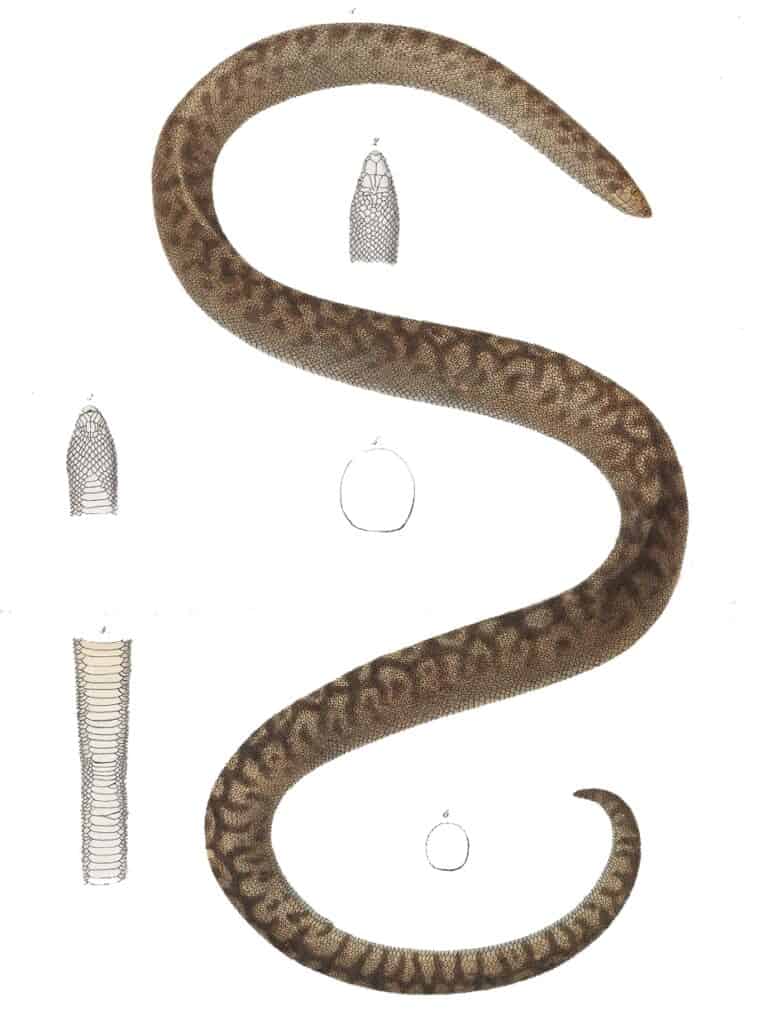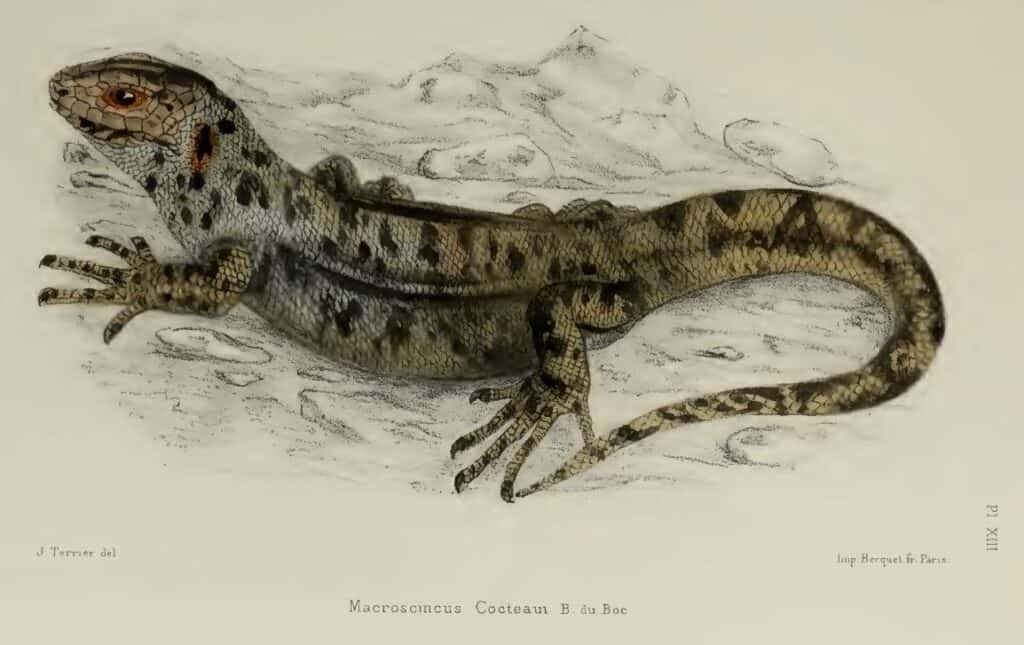Reptiles are one of the most successful species to live on planet earth. They lived alongside the dinosaurs millions of years ago and survived the extinction-level event that wiped out dinosaur life. Reptiles have lived alongside humans for thousands of years, but human activity has also caused some reptile extinctions. Here are 7 extinct reptiles to learn about, including snakes, skinks, lizards, and tortoises.
But before we dive in, what is a reptile?
What is a Reptile?

Reptiles usually have scaled skin or bone-type plates instead of fur or feathers.
©Artush/Shutterstock.com
Reptiles are cold-blooded animals that rely on the environment to warm up or cool off. Because of this, they are often less active in the winter months, and many hibernate.
They usually have scaled skin or bone-type plates instead of fur or feathers and lay soft-shelled eggs in warm nests left to incubate. Notable exceptions are snakes like pythons, boas, and rattlesnakes, which give birth to live young.
Reptiles first appeared in the fossil record 315 million years ago. Some dinosaurs were reptiles, but they were a diverse species of animals, including avians, insects, and amphibians.
1. Jamaican Giant Galliwasp (Celestus occiduus)

The Jamaican giant galliwasp is a smooth-skinned, skink-like reptile native to Jamaica’s Black River Morass and Westmoreland Morass.
©Simon J. Tonge / CC BY 3.0 – License
Galliwasps are anguid lizards in the Caribbean with variants in Puerto Rico, Costa Rica, and Cuba. They hunt small mammals, worms, mollusks, crabs, and insects from leaf litter and rocky outcrops.
However, the night-hunting, eleven-inch Jamaican giant galliwasp was last seen in 1840. It’s thought human encroachment into its forested, rocky habitats and ferocious introduced predators such as the Asian mongoose forced its extinction.
There is some hope we’ll see this allegedly-extinct reptile again. Because they are burrowers, night hunters, and some of their natural habitats are hard to access. There may be a few still in existence that we don’t know about.
2. Round Island Burrowing Boa (Bolyeria multocarinata)

The extinct Round Island boa was a burrowing boa endemic to Mauritius.
©UBA01:IZ11900105, Iconographia Zoologica: een papieren dierenrijk, Universiteit van Amsterdam / This work is in the public domain in its country of origin and other countries and areas where the copyright term is the author’s life plus 100 years or fewer. – License
The Round Island burrowing boa is an extinct species of snake endemic to Mauritius, where it lived in 0.58 square miles of hardwood forest and palm savanna. It was a small boa constrictor that ate lizards and reached up to three feet in length. It had a pointed snout and a light brown body with black spots and pink marbling.
Experts think its body shape made it fossorial, meaning it could burrow but did not live underground. Herpetologists think human hunting, habitat destruction, and introduced animals such as invasive goats and rabbits eroded its grassland environment and contributed to its decline. There are no subspecies, and the last one was seen in 1975. The Round Island burrowing boa’s closest living relative is the Round Island boa.
3. Kawekaweau (Hoplodactylus delcourti)

The Kawekaweau, or Delcourt’s Giant Gecko, was the largest gecko on earth.
©Lamiot / CC BY-SA 4.0 – License
This extinct reptile is also known as Delcourt’s giant gecko, but if you want to try out its native name, you pronounce it ‘cah-way-cahway-ow.’
The kawekaweau was the largest gecko ever found. It measured up to two feet long and is the subject of much scientific debate today. Some experts believe it was native to New Zealand, but others argue it was from New Caledonia, as there are no fossil specimens in New Zealand so far. There is only one specimen in existence today. Alain Delcourt found it abandoned in the basement of the Natural History Museum in Marseilles, France, in the 1980s.
Rumor has it that a Maori chieftain killed the last kawekaweau in 1873. He described the gecko as ‘brownish with red stripes and as thick as a man’s wrist.’ Whether this story is correct or not can’t be verified, but it’s the only account we have of a live kawekaweau.
The chieftain may have killed the final individual, but human settlers in the late 19th century most likely drove this reptile to extinction.
4. Rodrigues Giant Tortoise (Cylindraspis peltastes; Cylindraspis vosmaeri)
There are various species of giant tortoise alive today, but one species became extinct around the 1800s.
There were two species of Rodrigues giant tortoises classified in the testudines family. They were the domed Rodrigues giant tortoise (Cylindraspis peltastes), which weighed about 25 pounds, and the much larger saddle-backed Rodrigues giant tortoise (Cylindraspis vosmaeri), weighing in at 550 pounds and 42 inches long. They were both herbivores, but the larger Rodrigues tortoise was able to reach tree leaves several feet above the ground. It lived on Rodrigues Island, near Mauritius, in the Indian Ocean.
The smaller tortoise was domed, but the giant was saddle-backed with a long neck and resembled sauropod dinosaurs. They lived in herds and were very docile and slow-moving like modern tortoises. There are drawings of sailors riding them from the 1700s, but soon after their discovery, they were hunted to extinction. Thousands were loaded onto ships for food and transported to Mauritius for fat and oil.
Any remaining tortoises were killed when the island’s vegetation was burnt to make room for agriculture, adding these unique animals to the growing list of extinct reptiles.
5. Cape Verde Giant Skink (Chioninia coctei)

The Cape Verde Giant Skink had a unique transparent lower eyelid.
©J. Terrier / public domain – License
The Cape Verde giant skink was a lizard native to Cape Verde’s Branco and Raso Islets. Humans destroyed the leafy green forest environment there, and as the islets turned into deserts and humans also hunted them for food, the giant skink died out. None have been seen since the 1900s, and they were declared extinct in 2013.
This skink was a large herbivore up to 26 inches, including its tail which took up half its length. It ate vegetation but occasionally took nesting birds from the shoreline. Its transparent lower eyelid is one interesting feature not seen often in the animal kingdom. Herpetologists think this was so it could spot predators from below.
6. The Horned Turtle (Meiolania)
This giant turtle roamed New Caledonia, Australia, and Vanuatu thousands of years ago. Fossilized remains from Lord Howe Island indicate it died out around 2,800 years ago, possibly hunted to extinction by aboriginal settlers. The PNAS Journal describes how the species survived until human colonization.
The horned turtle looked like a dinosaur with a spiked tail and two horns above its eyes. It’s classified in the testudines family and was around eight feet long. Experts estimate it weighed up to 1,500 pounds! For comparison, the largest living Galapagos tortoises (Geochelone nigra) are around half that size.
The prehistoric-looking turtle’s horns grew from the back of its head and reached 23 inches, but their size would have prevented ducking back inside the shell when threatened. The type of predators that hunted a horned turtle are unknown, but a large shelled body, head spikes, and a spiked clubbed tail must have made it very hard to kill.
7. Titanoboa (Titanoboa cerrejonensis)

Scientists have discovered parts of the Titanoboa’s backbone and skull, which helped them estimate the
snake’s massive
size.
©Michael Rosskothen/Shutterstock.com
Meet Titanoboa, the largest extinct reptile on our list and the largest snake that’s ever lived.
Titanoboa cerrejonensis was a massive prehistoric snake and the longest-extinct reptile paleontologists know about. It was part of the snake genus Titanoboa, a boa constrictor species. Cerrejonensis was the largest. It reached lengths of 42 feet and had 250 vertebrae. Its skull alone was 16 inches long! Experts estimate its weight at 2,500 pounds, so it was certainly capable of hunting large prehistoric animals.
It lived in river systems and tropical rainforests much like modern anacondas (although the largest anaconda is only 30 feet long!) and was probably an apex predator capable of taking any animal that ventured too close. Despite its size, however, fossilized teeth indicate it was pescatarian, likely hunting large fish from its river system environment.
Much to the relief of its prey, Titanoboa went extinct around 60 million years ago. Experts think the climate cooled and changed faster than Titanoboa could adapt.
So, there we have 7 extinct reptiles, but the list could have been much longer. There’s a worrisome trend surrounding reptiles and human behavior. Today, there are 2000 reptile species on the international endangered species list, with the majority under pressure to survive because humans threaten their habitats.
Summary of 7 Extinct Reptiles
| Rank | Reptile | Date of Extinction |
|---|---|---|
| 1 | Jamaican Giant Galliwasp | 1840 |
| 2 | Round Island Burrowing Boa | 1975 |
| 3 | Kawekaweau | 1800s |
| 4 | Rodrigues Giant Tortoise | 1800s |
| 5 | Cape Verde Giant Skink | 2013 |
| 6 | Horned Turtle | 28 hundred years ago |
| 7 | Titanoboa | 60 million years ago |
The photo featured at the top of this post is © Jenny Sturm/Shutterstock.com
Thank you for reading! Have some feedback for us? Contact the AZ Animals editorial team.






